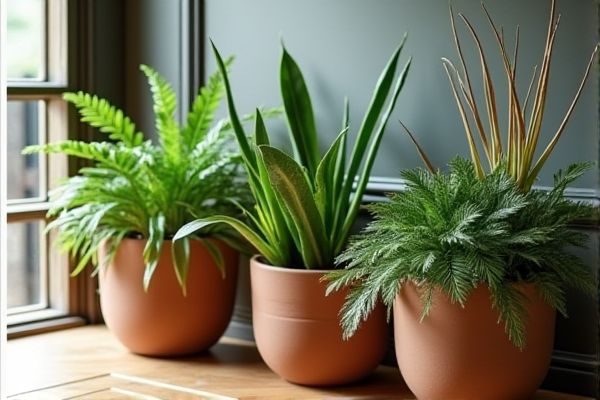
Self-watering planters provide a consistent moisture supply by using a reservoir system, reducing the need for frequent watering and preventing overwatering compared to traditional planters. Discover how choosing the right planter can improve the health of your plants and simplify your gardening routine in the rest of this article.
Table of Comparison
| Feature | Self-Watering Planters | Traditional Planters |
|---|---|---|
| Watering Method | Reservoir provides consistent moisture | Manual watering required |
| Maintenance | Low; refill reservoir periodically | Higher; frequent watering needed |
| Plant Health | Reduces overwatering and underwatering | Risk of inconsistent watering |
| Water Efficiency | High; conserves water | Lower; possible water waste |
| Cost | Generally higher upfront cost | Usually lower initial cost |
| Suitability | Ideal for busy gardeners and indoor plants | Suitable for traditional gardening and outdoor use |
Introduction to Self-Watering and Traditional Planters
Self-watering planters integrate a reservoir system that supplies water directly to plant roots, promoting consistent moisture levels and reducing the frequency of manual watering. Traditional planters rely on regular surface watering and drainage, which can lead to overwatering or underwatering if not carefully managed. This fundamental difference impacts plant health, maintenance needs, and water conservation efficiency.
How Self-Watering Planters Work
Self-watering planters use a built-in reservoir to supply water directly to the plant roots through capillary action or wicking systems, ensuring consistent moisture levels. This design minimizes overwatering and underwatering by allowing plants to absorb water as needed, promoting healthier root growth. You benefit from reduced maintenance and improved water efficiency compared to traditional planters that rely on manual watering.
Traditional Planters: Features and Functionality
Traditional planters rely on manual watering and often feature porous materials like terracotta or ceramic, which allow air exchange but require frequent moisture monitoring. They provide flexibility in design and size, accommodating various plant types, but depend heavily on consistent user care to maintain optimal soil hydration. Unlike self-watering systems, traditional planters do not include reservoirs or wicking mechanisms, making them less suited for automatic moisture regulation.
Water Efficiency Comparison
Self-watering planters significantly enhance water efficiency by utilizing a reservoir system that delivers moisture directly to plant roots, minimizing evaporation and runoff. Traditional planters often lose water through surface evaporation and overwatering, requiring more frequent irrigation to maintain soil moisture levels. Studies indicate self-watering systems can reduce water usage by up to 30-50% compared to conventional gardening methods.
Plant Health and Growth Differences
Self-watering planters maintain consistent moisture levels, reducing stress on plant roots and promoting healthier, faster growth compared to traditional planters, which often experience irregular watering cycles. The steady hydration in self-watering systems minimizes risk of overwatering or underwatering, common issues in traditional planter care. Studies show plants in self-watering containers exhibit stronger root systems and higher nutrient uptake, leading to improved overall vitality and bloom production.
Maintenance Requirements
Self-watering planters significantly reduce maintenance by providing a consistent water supply through a reservoir, minimizing the need for frequent watering and preventing over or underwatering. Traditional planters demand more regular attention as you must manually monitor soil moisture and water your plants accordingly, increasing the risk of inconsistent hydration. Choosing a self-watering planter can streamline your routine and ensure your plants thrive with less effort.
Cost Analysis: Initial Investment and Long-Term Savings
Self-watering planters typically require a higher initial investment, ranging from $20 to $50 compared to $5 to $15 for traditional planters. Over time, self-watering systems reduce water consumption by up to 30%, leading to significant savings on utility bills and less frequent plant replacement due to consistent moisture levels. Traditional planters may incur higher ongoing costs from frequent watering, increased soil erosion, and potential plant loss, affecting total cost efficiency.
Best Settings for Each Type of Planter
Self-watering planters perform best in environments with consistent indirect sunlight and moderate temperatures, as their water reservoirs maintain optimal moisture levels without over-saturation. Traditional planters require precise watering schedules tailored to plant species and soil types, with well-draining soil to prevent root rot and promote aeration. Adjustments in watering frequency and light exposure ensure each planter type supports healthy plant growth based on its water retention and distribution method.
Common Problems and Solutions
Self-watering planters address common problems like inconsistent watering and root rot by providing a steady water supply through a reservoir, ensuring plants receive adequate moisture without overwatering. Traditional planters often face issues such as soil drying out quickly and uneven water distribution, which can stress your plants and hinder growth. Using self-watering systems can help maintain optimal hydration levels, reducing the risk of underwatering or overwatering commonly seen with manual watering in traditional pots.
Choosing the Right Planter for Your Needs
Self-watering planters reduce the frequency of watering by providing a consistent moisture supply through a built-in reservoir, ideal for busy individuals or those seeking low-maintenance gardening. Traditional planters require more frequent attention and manual watering, offering greater control over soil moisture but demanding regular care. Choosing the right planter depends on your lifestyle, plant type, and watering habits to ensure optimal growth and convenience.
 homyna.com
homyna.com